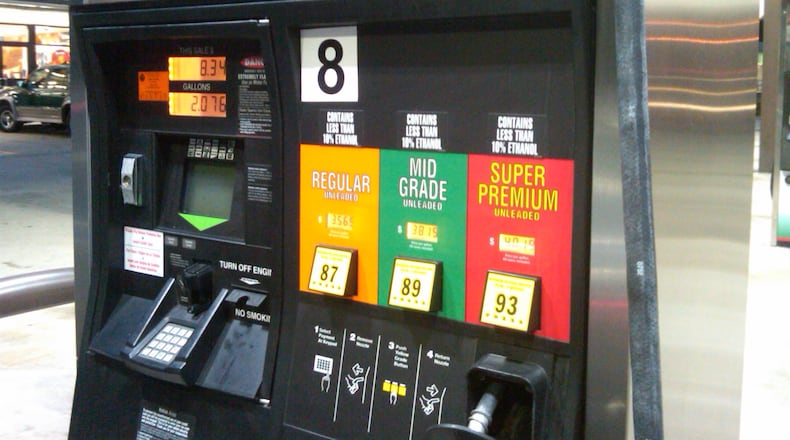The proposal would raise an additional $1.2 billion a year for road and bridge projects statewide and give the state Department of Transportation authority to lower speed limits based on road conditions.
The tax increase would begin July 1 and then be tied to inflation in future years, allowing it to automatically rise without returning to lawmakers for further approvals. The same 60-40 percentage split would continue between the state and local jurisdictions.
“The indexing is crucial to ensuring we are not here again in four or six years giving the same presentation about deteriorating road conditions and safety hazards,” Marchbanks said to the House Finance Committee on Thursday.
Credit: DaytonDailyNews
The automatic inflationary increases is a concern for state Rep. Scott Lipps, R-Franklin, who said he would like a deep discussion on whether indexing should be approved. Lipps, however, said he supports the 18-cent increase and applauds DeWine for “accepting the pain” of making such a proposal.
State Rep. Phil Plummer, R-Clayton, said “Somebody has got to pay for the roads we all use….They have kicked the can down the road too long. It’s time to fix the roads.”
State Rep. Rick Perales, R-Beavercreek, another House Finance Committee member, said he favors raising the gas tax but isn’t sure if it should be 18 cents all at once.
Related: ODOT Director says Ohio needs more money to fix roads or ‘more people will get hurt’
“This has been let go for so long and our transportation infrastructure is so poor right now in Ohio and it gets worse and worse and we keep putting off the improvements we need,” he said. “You use the roads, you pay for gas and it goes toward the improvements.”
The additional funding will allow ODOT to fund major new projects, including the widening of U.S. 35 in Dayton and repairs to I-75 near Cincinnati, Marchbanks says in his remarks.
“If you drive 13,000 miles per year, roughly the U.S. average, in a 2015 Ford F-150 pickup with four-wheel drive and a V8 engine, your fuel bill would increase $2.65 per week,” Marchbanks says. “If you drive a 2015 Honda Accord, you would pay just $1.61 per week, less than the price of a cup of coffee.”
Some government entities pay a discounted gas tax: mass transit pays one penny of the current 28-cents-per-gallon tax; school districts pay 22 cents per gallon; federal government vehicles pay no gas taxes; and county board of developmental disability vehicles pay 22 cents, according to ODOT, which pays the full state tax but not the federal tax.
How does Ohio compare?
If lawmakers agree to the entire increase, the total state gas tax would be 46 cents per gallon. That would put Ohio’s gas tax in line with neighboring states: 58.7 cents in Pennsylvania, 44.1 cents in Michigan, 42.9 cents in Indiana, 35.7 cents in West Virginia and 26 cents in Kentucky.
Pennsylvania’s gas tax is the highest in the nation. Alaska’s 14-cent gas tax is the lowest.
The Ohio Constitution mandates that gas tax revenue only be used for construction, reconstruction, maintenance and repair of public highways and bridges.
Overall, the transportation budget bill spells out $7.4 billion in spending over two years, assuming lawmakers approve the 18-cent increase.
Related: ODOT Director says Ohio needs more money to fix roads or ‘more people will get hurt’
Each penny increase in the gas tax raises an additional $66 million a year.
The current 28-cent gas tax was last raised in 2005. It costs the average Ohio motorist, who drives 12,900 miles a year and gets 24.7 mpg, $146.30 a year, according to information from the Ohio Trucking Association.
The proposal, which must be signed into law by March 31, still needs approval in both the House and Senate. That could be a heavy lift as lawmakers are hesitant to raise taxes. Many legislators have indicated they need to be convinced that the need is as great as the DeWine administration says it is.
How would speed limits be changed?
ODOT has the authority to impose variable speed limits on a handful of interstate stretches, based on road conditions. For example, ODOT can drop the speed limit during snow storms that hit I-90 east of Cleveland.
In addition to the tax increase, Marchbanks is also asking for authority to apply variable speed limits across the state.
“What we’re talking about is applying it where we have construction projects and we have also known safety issues such as white-outs or other issues impacting traffic, impacting safety of our traveling motorists,” he said.
When asked if ODOT is interested in raising the highway speed limit, Marchbanks said “No. People are driving too fast already.”
Marchbanks, a Dayton native, holds a doctorate in American History from Ohio University and a bachelor’s degree in political science from University of Dayton.
Should Ohio raise the gas tax? Plan expected tomorrow. https://t.co/COgkWlDS7P
— Ohio Politics (@Ohio_Politics) February 20, 2019
About the Author


